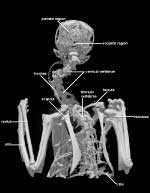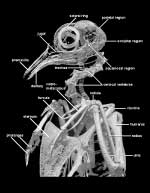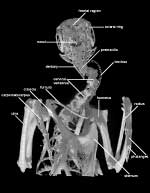The black-naped fruit-dove (Ptilinopus melanospila) is geographically distributed throughout Java, the Celebes Sea, the Moluccas Islands, and the Southern Philippines (Delacour, 1947; del Hoyo et al., 1997; Gibbs et al., 2001; Schleucher, 2002). The species is sexually dichromatic. The body of males is mostly green, however the head and neck are pale gray, the chin, throat, and lower belly are yellow, and there is a black spot on the nape of the neck. In contrast, females are almost entirely green (Delacour, 1947; del Hoyo et al., 1997; Gibbs et al., 2001). Length ranges from 21-27 cm and the wingspan ranges from 11-17 cm. Weight is typically between 92-120 g (del Hoyo et al., 1997; Gibbs et al., 2001).
The genus Ptilinopus includes all fruit-doves, with a total of 51 species. The genus probably originated in New Guinea but now has a geographical distribution throughout Southeast Asia and Australia (Gibbs et al., 1997). All species of Ptilinopus are mostly frugivorous; P. melanospila is exclusively so (Schleucher, 2002).
The habitat of the black-naped fruit dove is located in tropical or temperate climates and includes forests, forest edge, and scrub lands (Sibley and Monroe, 1990; Schleucher, 2002). Individuals often are found in agricultural areas or on isolated fruit trees (del Hoyo et al., 1997; Schleucher, 2002). The black-nape fruit dove has been observed to migrate locally to regions of high food abundance.
The black-naped fruit-dove subsists on fruit and berries, especially figs. Individuals typically are solitary or occur in pairs, although large groups are known to form at fruit trees. The breeding season varies considerably according to geographic location of a population. For example, in Java the breeding season occurs from February to September and also in December. In Wallacea breeding occurs in September and May and in Sabah in October. Nests are platform shaped and formed out of twigs and grass stems. Typically, nests are not placed high above ground level (Gibbs et al., 2001). Like breeding, the nesting period also varies throughout the geographical distribution of the species (del Hoyo et al., 1997). Clutch size is one egg and in captivity the incubation period has been recorded as 18-26 days (del Hoyo et al., 1997).
Additional Information on the Skull and Upper Body
Click on the thumbnails below for labeled images of the skull and upper body in standard anatomical views.

Literature
del Hoyo, J., A. Elliott, and J. Sargatal (eds.). 1997. Handbook of the Birds of the World. Volume 4. Sandgrouse to Cuckoos. Lynx Edicions, Barcelona.
Delacour, J. 1947. Birds of Malaysia. The Macmillan Company, New York, NY. pp 382.
Gibbs, D., E. Barnes, and J. Cox. 2001. Pigeons and Doves. Yale University Press, New Haven, CT. 615 pp.
Schleucher, E. 2002. Metabolism, body temperature and thermal conductance of fruit-doves (Aves: Columbidae, Treroninae). Comparative Biochemistry and Physiology Part A 131:417-428.
Sibley, C. G., and B. L. Monroe Jr. 1990. Distribution and Taxonomy of Birds of the World. Yale University Press, New Haven, CT. 1111 pp.
Links
Ptilinopus melanospila page at the Smithsonian National Zoological Park












